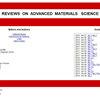Promoting low carbon construction using alkali-activated materials: A modeling study for strength prediction and feature interaction
IF 3.9
4区 材料科学
Q2 MATERIALS SCIENCE, MULTIDISCIPLINARY
引用次数: 0
Abstract
In place of Portland cement concrete, alkali-activated materials (AAMs) are becoming more popular because of their widespread use and low environmental effects. Unfortunately, reliable property predictions have been impeded by the restrictions of conventional materials science methods and the large compositional variability of AAMs. A support vector machine (SVM), a bagging regressor (BR), and a random forest regressor (RFR) were among the machine learning models developed in this study to assess the compressive strength (CS) of AAMs in an effort to gain an answer to this topic. Improving predictions in this crucial area was the goal of this study, which used a large dataset with 381 points and eight input factors. Also, the relevance of contributing components was assessed using a shapley additive explanations (SHAP) approach. In terms of predicting AAMs CS, RFR outperformed BR and SVM. Compared to the RFR model’s 0.96使用碱活性材料促进低碳建筑:强度预测和特征相互作用的建模研究
碱活性材料(AAMs)因其使用广泛且对环境影响较小,正越来越多地取代硅酸盐水泥混凝土。遗憾的是,由于传统材料科学方法的限制和 AAM 成分的巨大变异性,可靠的性能预测一直受到阻碍。本研究开发的机器学习模型包括支持向量机 (SVM)、袋装回归器 (BR) 和随机森林回归器 (RFR),用于评估 AAM 的抗压强度 (CS),旨在为这一问题找到答案。改进这一关键领域的预测是本研究的目标,本研究使用了一个包含 381 个点和 8 个输入因子的大型数据集。此外,还使用了夏普利加法解释(SHAP)方法对贡献成分的相关性进行了评估。在预测 AAMs CS 方面,RFR 的表现优于 BR 和 SVM。RFR 模型的 R 2 值为 0.96,而 SVM 和 BR 模型的 R 2 值分别为 0.89 和 0.93。此外,RFR 模型的平均绝对误差值为 4.08 兆帕,而 SVM 和 BR 模型的绝对误差值分别为 6.80 兆帕和 5.83 兆帕,这进一步证明了 RFR 模型的准确性。根据 SHAP 的研究结果,对强度贡献最大的两个因素是集料体积比和反应性。对强度影响最大的因素是比表面积、硅酸盐模量和氢氧化钠浓度。使用所生成的模型来找出各种输入参数值下的 AAM 的 CS 值,有助于减少昂贵而耗时的实验室测试。为了找到合成橡胶的最佳原材料用量,学术界和工业界都会发现这项 SHAP 研究非常有用。
本文章由计算机程序翻译,如有差异,请以英文原文为准。
求助全文
约1分钟内获得全文
求助全文
来源期刊

Reviews on Advanced Materials Science
工程技术-材料科学:综合
CiteScore
5.10
自引率
11.10%
发文量
43
审稿时长
3.5 months
期刊介绍:
Reviews on Advanced Materials Science is a fully peer-reviewed, open access, electronic journal that publishes significant, original and relevant works in the area of theoretical and experimental studies of advanced materials. The journal provides the readers with free, instant, and permanent access to all content worldwide; and the authors with extensive promotion of published articles, long-time preservation, language-correction services, no space constraints and immediate publication.
Reviews on Advanced Materials Science is listed inter alia by Clarivate Analytics (formerly Thomson Reuters) - Current Contents/Physical, Chemical, and Earth Sciences (CC/PC&ES), JCR and SCIE. Our standard policy requires each paper to be reviewed by at least two Referees and the peer-review process is single-blind.
 求助内容:
求助内容: 应助结果提醒方式:
应助结果提醒方式:


